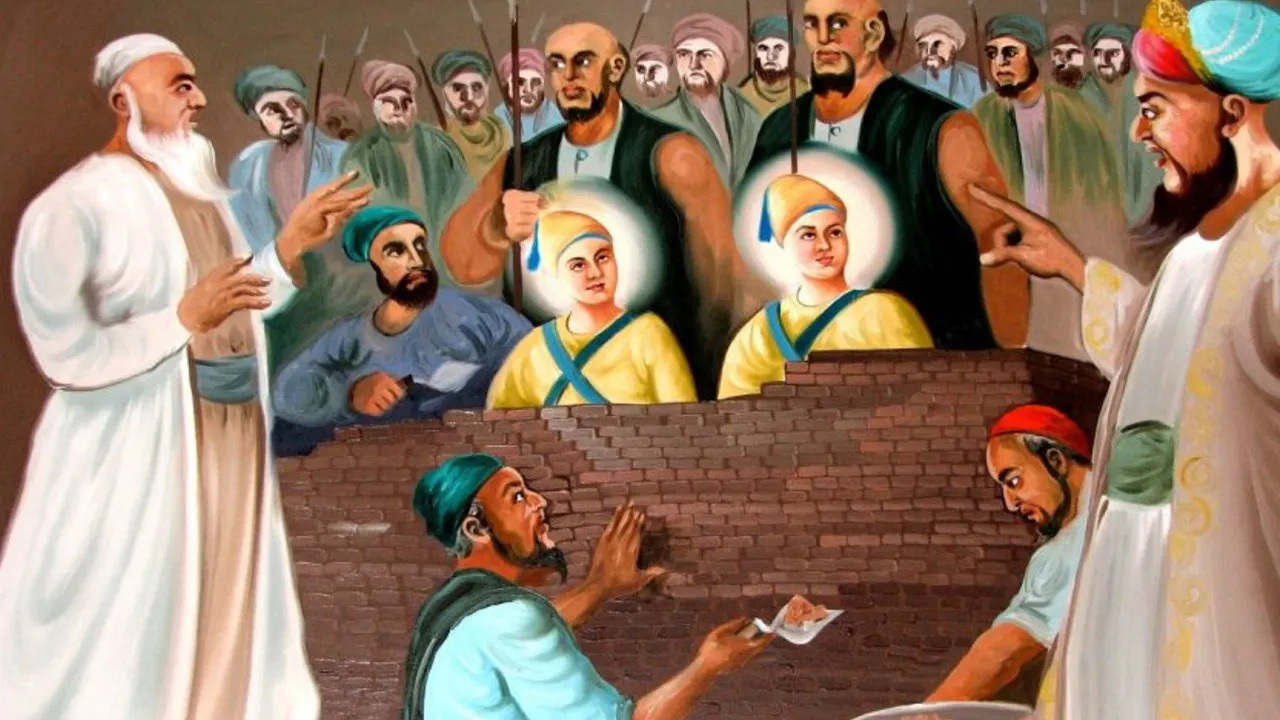Sahibzada Fateh Singh Ji Youngest Martyr In History: Sahibzada Fateh Singh Ji Youngest Martyr In History Early Life On October 24, 1699, Sahibzada Fateh Singh Ji was born in Anandpur Sahib, Punjab, India. He was Guru Gobind Singh Ji and Mata Jito Ji’s youngest child. Sahibzada Ajit Singh Ji and Sahibzada Jujhar Singh Ji were his older brothers.
When his father Guru Gobind Singh Ji departed for the holy abode, Sahibzada Fateh Singh Ji was just two years old. After that, his mother Mata Jito Ji raised him. The children of Mata Jito Ji were raised with a love of Sikhi.
Sahibzada Fateh Singh Ji was a young man of great bravery and valor. He was a great horseman and loved horses a lot. He was a master in archery as well.
He took part in the Battle of Chamkaur against the Mughals when he was only eleven years old. He heroically battled with his siblings, and the Sikhs honored him for it.
The Mughals seized the Sahibzadas after the Battle of Chamkaur, and they were sent to Delhi. They were imprisoned and subjected to regular abuse.
Sahibzada Fateh Singh Ji and his brothers maintained their Sikhi faith in the face of torture. At the age of barely six years old, they were eventually killed on November 13, 1705, for their refusal to become Muslims.
The Sikhs were motivated to fight against the Mughals’ oppression by the Sahibzadas’ sacrifice. The Sikhs still honor their sacrifice today.
Table of Contents
His Contribution to the Sikh Independence Movement

Over many years, many courageous men and women struggled for the independence of the Sikhs. Sahibzada Fateh Singh Ji was a significant player in this conflict.
Fateh Singh, the son of Guru Gobind Singh Ji, the tenth Sikh Guru, was born in 1699. While his father was slain in combat when he was only a little kid, he quickly assumed the role of leader, becoming one of the major players in the Sikh Struggle for Independence.
A courageous and tenacious commander, Fateh Singh swiftly established a reputation for his military abilities. He was essential in pushing the Mughal army out of the Punjab area and commanded several successful wars against them.
The Mughals captured him in 1710 and executed him, but his sacrifice only inspired the Sikh people to carry on their struggle. The Sikh Empire was finally founded in 1849 as a consequence of the long-lasting Sikh Struggle for Independence.
A courageous and inspirational figure, Fateh Singh Ji played a significant part in the Sikh War for Independence. The Sikh community still honors his legacy and remembers him as one of its heroes.
Sahibzada Fateh Singh Ji Youngest Martyr In History
One of the sad moments in Sikh history is the martyrdom of Sahibzada Fateh Singh Ji. The Mughal Emperor Aurangzeb had two of Guru Gobind Singh Ji’s young sons, Sahibzada Fateh Singh Ji and Sahibzada Zorawar Singh Ji, bricked alive on November 24th, 1704, at the age of 6 and 9 respectively.
Aurangzeb carried out this heinous deed as retaliation for Guru Gobind Singh Ji’s previous escape from the Gwalior Fort jail. The Mughal army kidnapped the Guru’s two younger sons and took them before the Emperor, who insisted they convert to Islam.
Aurangzeb ordered the lads to be bricked up alive in a wall when they refused. Even in the face of death, the two Sahibzadas maintained their faith, and their martyrdom is regarded as one of the most valiant deeds in Sikh history.
Our Services: Digital Services, Digital Marketing Professional Services, How to Buy and Sell Websites, Login Adsense Account, Google Adsense Account, Adsense Approved Websites For Sale,
Sahibzada Fateh Singh Ji’s Legacy
Operation Blue Star, a military attack on the Harmandir Sahib complex in Amritsar, Punjab, was conducted by the Indian Army in the early hours of June 3, 1984. Sikh militants headed by Jarnail Singh Bhindranwale had taken control of the complex housing the Golden Temple, the holiest place for Sikhs, with the intention of establishing an independent Sikh state inside India.
Bhindranwale and several of his supporters died during the operation, which lasted ten days and resulted in the deaths of hundreds of Sikh people. The temple was also severely damaged. Prime Minister Indira Gandhi was killed by Sikh extremists as payback for the operation.
India is still plagued by the effects of Operation Blue Star and the Sikh militancy that followed. More than 30 years later, Sikhs in India and all across the globe are still deeply affected by the remembrance of those terrible times.
The legacy of Operation Blue Star is one of betrayal for many Sikhs. They think that the Golden Temple, which is not only the holiest place in Sikhism but also a symbol of Sikh pride and identity, was purposefully attacked by the Indian government.
The operation aroused a strong feeling of resentment and fury that still simmers today since it was seen as an assault on the Sikh community. Sikh militancy grew in the years that followed, sparking a bloody conflict with the Indian government.
The violence, which resulted in the deaths of thousands of Sikhs, was finally put to an end in 1992 when the Punjab state came under military authority. India is still plagued by the effects of those terrible times, and the wounds are still not completely closed.
For those who were murdered or harmed by Operation Blue Star and the ensuing bloodshed, the Sikh community has long wanted justice. The relatives of the victims should get compensation, and the offenders should be brought to justice.
Although the Indian government has made considerable progress in addressing these objectives, many Sikhs believe that more needs to be done. India is still suffering from the effects of Operation Blue Star, and the scars from 1984 are still very fresh.
Read more: Youngest Martyr In History, youngest freedom fighters, History of Sahibzada Fateh Singh Ji, Youngest Martyr In History



